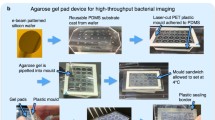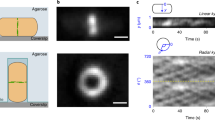Abstract
The atomic force microscope has become an established research tool for imaging microorganisms with unprecedented resolution. However, its use in microbiology has been limited by the difficulty of proper bacterial immobilization. Here, we have developed a microfluidic device that solves the issue of bacterial immobilization for atomic force microscopy under physiological conditions. Our device is able to rapidly immobilize bacteria in well-defined positions and subsequently release the cells for quick sample exchange. The developed device also allows simultaneous fluorescence analysis to assess the bacterial viability during atomic force microscope imaging. We demonstrated the potential of our approach for the immobilization of rod-shaped Escherichia coli and Bacillus subtilis. Using our device, we observed buffer-dependent morphological changes of the bacterial envelope mediated by the antimicrobial peptide CM15. Our approach to bacterial immobilization makes sample preparation much simpler and more reliable, thereby accelerating atomic force microscopy studies at the single-cell level.

Similar content being viewed by others

References
Beveridge, T. J.; Graham, L. L. Surface layers of bacteria. Microbiol. Rev. 1992, 55, 684–705.
Butt, H. J.; Wolff, E. K.; Gould, S. A. C.; Dixon Northern, B.; Peterson, C. M.; Hansma, P. K. Imaging cells with the atomic force microscope. J. Struct. Biol. 1990, 105, 54–61.
Pum, D.; Sleytr, U. B. Monomolecular reassembly of a crystalline bacterial cell surface layer (S-layer) on untreated and modified silicon surfaces. Supramol. Sci. 1995, 2, 193–197.
Schabert, F.; Henn, C.; Engel, A. Native Escherichia coli OmpF porin surfaces probed by atomic force microscopy. Science 1995, 268, 92–94.
Drake, B.; Prater, C.; Weisenhorn, A.; Gould, S.; Albrecht, T.; Quate, C.; Cannell, D.; Hansma, H.; Hansma, P. Imaging crystals, polymers, and processes in water with the atomic force microscope. Science 1989, 243, 1586–1589.
Beaussart, A.; Baker, A. E.; Kuchma, S. L.; El-Kirat-Chatel, S.; O’Toole, G. A.; Dufrêne, Y. F. Nanoscale adhesion forces of Pseudomonas aeruginosa type IV pili. ACS Nano 2014, 8, 10723–10733.
Hayhurst, E. J.; Kailas, L.; Hobbs, J. K.; Foster, S. J. Cell wall peptidoglycan architecture in Bacillus subtilis. Proc. Natl. Acad. Sci. USA 2008, 105, 14603–14608.
Fantner, G. E.; Barbero, R. J.; Gray, D. S.; Belcher, A. M. Kinetics of antimicrobial peptide activity measured on individual bacterial cells using high-speed atomic force microscopy. Nat. Nanotechnol. 2010, 5, 280–285.
Dufrêne, Y. F.; Martínez-Martín, D.; Medalsy, I.; Alsteens, D.; Müller, D. J. Multiparametric imaging of biological systems by force-distance curve-based AFM. Nat. Methods 2013, 10, 847–854.
Ando, T.; Uchihashi, T.; Scheuring, S. Filming biomolecular processes by high-speed atomic force microscopy. Chem. Rev. 2014, 114, 3120–3188.
Radmacher, M.; Tillmann, R. W.; Fritz, M.; Gaub, H. E. From molecules to cells: Imaging soft samples with the atomic force microscope. Science 1992, 257, 1900–1905.
Dufrêne, Y. F. Using nanotechniques to explore microbial surfaces. Nat. Rev. Microbiol. 2004, 2, 451–460.
Karrasch, S.; Dolder, M.; Schabert, F.; Ramsden, J.; Engel, A. Covalent binding of biological samples to solid supports for scanning probe microscopy in buffer solution. Biophys. J. 1993, 65, 2437–2446.
Kasas, S.; Ikai, A. A method for anchoring round shaped cells for atomic force microscope imaging. Biophys. J. 1995, 68, 1678–1680.
Razatos, A.; Ong, Y. L.; Sharma, M. M.; Georgiou, G. Molecular determinants of bacterial adhesion monitored by atomic force microscopy. Proc. Natl. Acad. Sci. USA 1998, 95, 11059–11064.
Meyer, R. L.; Zhou, X. F.; Tang, L.; Arpanaei, A.; Kingshott, P.; Besenbacher, F. Immobilisation of living bacteria for AFM imaging under physiological conditions. Ultramicroscopy 2010, 110, 1349–1357.
Liu, Y.; Strauss, J.; Camesano, T. A. Adhesion forces between Staphylococcus epidermidis and surfaces bearing self-assembled monolayers in the presence of model proteins. Biomaterials 2008, 29, 4374–4382.
Vadillo-Rodríguez, V.; Busscher, H. J.; Van Der Mei, H. C.; De Vries, J.; Norde, W. Role of lactobacillus cell surface hydrophobicity as probed by AFM in adhesion to surfaces at low and high ionic strength. Colloids Surf. B Biointerfaces 2005, 41, 33–41.
Zhang, T.; Chao, Y. Q.; Shih, K.; Li, X. Y.; Fang, H. H. P. Quantification of the lateral detachment force for bacterial cells using atomic force microscope and centrifugation. Ultramicroscopy 2011, 111, 131–139.
Vadillo-Rodriguez, V.; Busscher, H. J.; Norde, W.; de Vries, J.; Dijkstra, R. J. B.; Stokroos, I.; van der Mei, H. C. Comparison of atomic force microscopy interaction forces between bacteria and silicon nitride substrata for three commonly used immobilization methods. Appl. Environ. Microbiol. 2004, 70, 5441–5446.
van der Mei, H. C.; Busscher, H. J.; Bos, R.; de Vries, J.; Boonaert, C. J. P.; Dufrêne, Y. F. Direct probing by atomic force microscopy of the cell surface softness of a fibrillated and nonfibrillated oral streptococcal strain. Biophys. J. 2000, 78, 2668–2674.
Odermatt, P. D.; Shivanandan, A.; Deschout, H.; Jankele, R.; Nievergelt, A. P.; Feletti, L.; Davidson, M. W.; Radenovic, A.; Fantner, G. E. High-resolution correlative microscopy: Bridging the gap between single molecule localization microscopy and atomic force microscopy. Nano Lett. 2015, 15, 4896–4904.
Hertz, H. Ueber die Berührung fester elastischer Körper. J. Für Die Reine Und Angew. Math. 1882, 92, 156–171.
Johnson, K. L.; Kendall, K.; Roberts, A. D. Surface energy and the contact of elastic solids. Proc. Roy. Soc. A: Math. Phys. Eng. Sci. 1971, 324, 301–313.
Derjaguin, B. V; Muller, V. M.; Toporov, Y. P. Effect of contact deformations on the adhesion of particles. J. Colloid Interface Sci. 1975, 53, 314–326.
Butt, H. J.; Cappella, B.; Kappl, M. Force measurements with the atomic force microscope: Technique, interpretation and applications. Surf. Sci. Rep. 2005, 59, 1–152.
Huang, L. R.; Cox, E. C.; Austin, R. H.; Sturm, J. C. Continuous particle separation through deterministic lateral displacement. Science 2004, 304, 987–990.
Wyatt Shields IV, C.; Reyes, C. D.; López, G. P. Microfluidic cell sorting: Areview of the advances in the separation of cells from debulking to rare cell isolation. Lab Chip 2015, 15, 1230–1249.
Dufrêne, Y. F. Atomic force microscopy in microbiology: New structural and functional insights into the microbial cell surface. mBio 2014, 5, e01363–14.
Longo, G.; Kasas, S. Effects of antibacterial agents and drugs monitored by atomic force microscopy. Wiley Interdiscip. Rev. Nanomed. Nanobiotechnol. 2014, 6, 230–244.
Braga, P. C.; Ricci, D. Atomic force microscopy: Application to investigation of Escherichia coli morphology before and after exposure to cefodizime. Antimicrob. Agents Chemother. 1998, 42, 18–22.
Francius, G.; Domenech, O.; Mingeot-Leclercq, M. P.; Dufrêne, Y. F. Direct observation of Staphylococcus aureus cell wall digestion by lysostaphin. J. Bacteriol. 2008, 190, 7904–7909.
Yeaman, M. R.; Yount, N. Y. Mechanisms of antimicrobial peptide action and resistance. Pharmacol. Rev. 2003, 55, 27–55.
Brogden, K. A. Antimicrobial peptides: Pore formers or metabolic inhibitors in bacteria? Nat. Rev. Microbiol. 2005, 3, 238–250.
Peraro, M. D.; van der Goot, F. G. Pore-forming toxins: Ancient, but never really out of fashion. Nat. Rev. Microbiol. 2016, 14, 77–92.
Sato, H.; Feix, J. B. Osmoprotection of bacterial cells from toxicity caused by antimicrobial hybrid peptide CM15. Biochemistry 2006, 45, 9997–10007.
Dufrêne, Y. F. Atomic force microscopy and chemical force microscopy of microbial cells. Nat. Protoc. 2008, 3, 1132–1138.
Liu, Y. T.; Camesano, T. A. Immobilizing bacteria for atomic force microscopy imaging or force measurements in liquids. In Microbial Surfaces: Structure, Interactions, and Reactivity. Camesano, T. A.; Mello, C. M., Eds.; American Chemical Society: San Francisco, 2008; pp. 163–188.
Doktycz, M. J.; Sullivan, C. J.; Hoyt, P. R.; Pelletier, D. A.; Wu, S.; Allison, D. P. AFM imaging of bacteria in liquid media immobilized on gelatin coated mica surfaces. Ultramicroscopy 2003, 97, 209–216.
Obst, M.; Dittrich, M. Living under an atomic force microscope. Geobiology 2005, 3, 179–193.
Allison, D. P.; Sullivan, C. J.; Mortensen, N. P.; Retterer, S. T.; Doktycz, M. Bacterial immobilization for imaging by atomic force microscopy. J. Vis. Exp. 2011, 2880.
Pelling, A. E.; Li, Y.; Shi, W.; Gimzewski, J. K. Nanoscale visualization and characterization of Myxococcus xanthus cells with atomic force microscopy. Proc. Natl. Acad. Sci. USA 2005, 102, 6484–6489.
Read, N.; Connell, S.; Adams, D. G. Nanoscale visualization of a fibrillar array in the cell wall of filamentous cyanobacteria and its implications for gliding motility. J. Bacteriol. 2007, 189, 7361–7366.
Liu, B. Y.; Zhang, G. M.; Li, X. L.; Chen, H. Effect of glutaraldehyde fixation on bacterial cells observed by atomic force microscopy. Scanning 2012, 34, 6–11.
Colville, K.; Tompkins, N.; Rutenberg, A. D.; Jericho, M. H. Effects of poly(L-lysine) substrates on attached Escherichia coli bacteria. Langmuir 2010, 26, 2639–2644.
Turner, R. D.; Thomson, N. H.; Kirkham, J.; Devine, D. Improvement of the pore trapping method to immobilize vital coccoid bacteria for high-resolution AFM: A study of Staphylococcus aureus. J. Microsc. 2010, 238, 102–110.
Kailas, L.; Ratcliffe, E. C.; Hayhurst, E. J.; Walker, M. G.; Foster, S. J.; Hobbs, J. K. Immobilizing live bacteria for AFM imaging of cellular processes. Ultramicroscopy 2009, 109, 775–780.
Chen, P. P.; Xu, L. P.; Liu, J.; Hol, F. J. H.; Keymer, J. E.; Taddei, F.; Han, D.; Lindner, A. B. Nanoscale probing the kinetics of oriented bacterial cell growth using atomic force microscopy. Small 2014, 10, 3018–3025.
Regehr, K. J.; Domenech, M.; Koepsel, J. T.; Carver, K. C.; Ellison-Zelski, S. J.; Murphy, W. L.; Schuler, L. A.; Alarid, E. T.; Beebe, D. J. Biological implications of polydimethylsiloxane-based microfluidic cell culture. Lab Chip 2009, 9, 2132–2139.
Stiefel, P.; Schmidt-Emrich, S.; Maniura-Weber, K.; Ren, Q. Critical aspects of using bacterial cell viability assays with the fluorophores SYTO9 and propidium iodide. BMC Microbiol. 2015, 15, 36.
Schindelin, J.; Arganda-Carreras, I.; Frise, E.; Kaynig, V.; Longair, M.; Pietzsch, T.; Preibisch, S.; Rueden, C.; Saalfeld, S.; Schmid, B. et al. Fiji: An open-source platform for biological-image analysis. Nat. Methods 2012, 9, 676–682.
Schneider, C. A.; Rasband, W. S.; Eliceiri, K. W. NIH Image to ImageJ: 25 years of image analysis. Nat. Methods 2012, 9, 671–675.
Hutter, J. L.; Bechhoefer, J. Calibration of atomic-force microscope tips. Rev. Sci. Instrum. 1993, 64, 1868–1873.
Nečas, D.; Klapetek, P. Gwyddion: An open-source software for SPM data analysis. Cent. Eur. J. Phys. 2012, 10, 181–188.
Acknowledgements
This work was funded by the Swiss National Science Foundation (Nos.205321_134786, 205320_152675), and by the European Union FP7/2007-2013/ERC under Grant Agreement No. 307338-NaMic, and Eurostars E!8213.
Author information
Authors and Affiliations
Corresponding author
Electronic supplementary material
Rights and permissions
About this article
Cite this article
Peric, O., Hannebelle, M., Adams, J.D. et al. Microfluidic bacterial traps for simultaneous fluorescence and atomic force microscopy. Nano Res. 10, 3896–3908 (2017). https://doi.org/10.1007/s12274-017-1604-5
Received:
Revised:
Accepted:
Published:
Issue Date:
DOI: https://doi.org/10.1007/s12274-017-1604-5



